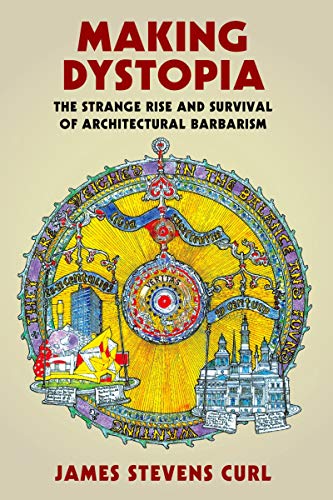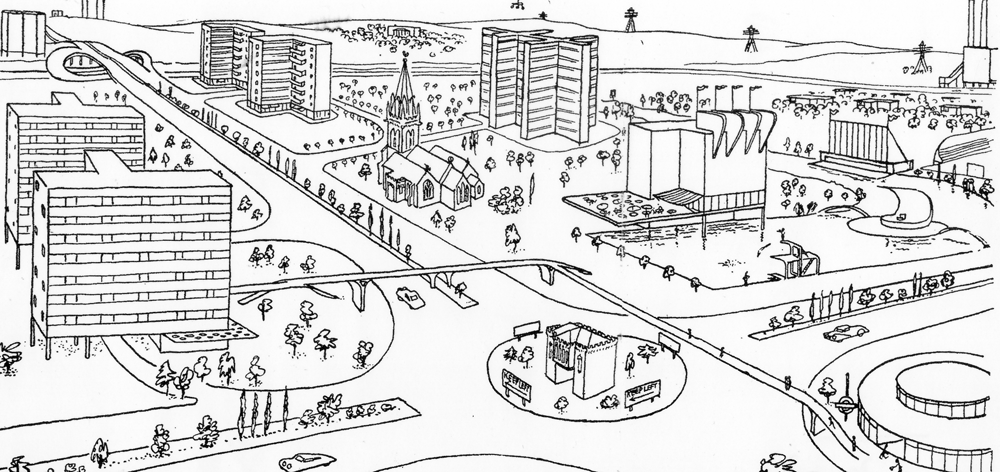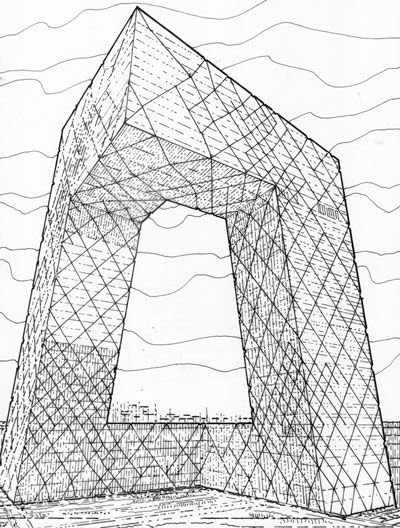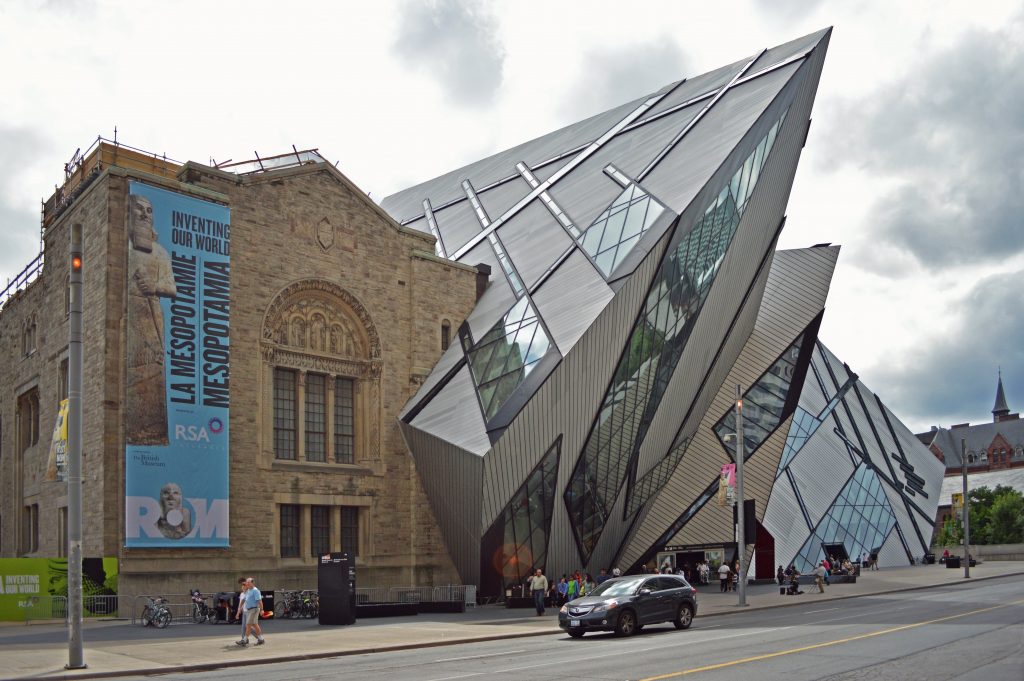Architect Ludwig Mies Van Der Rohe standing in front of building model of Illinois Technical Building. (Photo by Arthur Siegel/The LIFE Images Collection via Getty Images/Getty Images)
Renaissance scholar Petrarch once wrote of Roman consul Scipio Africanus in a passage that remains strikingly relevant to the contemporary state of architecture: “Then perhaps, with the darkness dispelled our descendants will be able to return to the pure radiance of the past.” Since then, regrettably, that “pure radiance” has been noticeably absent from the century-long “Modern Movement” in architecture and urban planning. The dystopias it has created were not celebrated for illumination other than garish advertisements for unnecessary trivialities. Yet this darkness over the built environment can be explained by a powerful “modernist” ideology; it confines discourse to a narrow stylistic approach to the design of buildings, one only approved by a small coterie of architects and their disciples, and given further credence by theorists, apologists, and other protagonists. The forthcoming will demonstrate that the dominance of modern architecture has become a dangerous cult, an aberration, and a catastrophe for civilized urban life.
Modernist ideology began in its early manifestations from the 1920s, when some architects sought to create plain, empty surfaces and disturbing asymmetries, deliberately rejecting all tradition and historical allusions. This destructive tendency has continued, even while undergoing superficial variations, right up to the present day. Following the disaster of World War I, modernism rejected academicism, historicism, and tradition, and embraced that which is self-consciously new or fashionable, with pronounced tendencies towards abstraction. The term suggests architecture from which, for the first time in the history of humankind, all ornament and historical allusions were expunged: originated and energetically promoted by Ludwig Miës van der Rohe, Le Corbusier, Walter Gropius, and others,it had flat roofs, smooth, white-rendered walls, long horizontal strips of window, and frame construction so that external and internal walls were non-structural (i.e. they did not bear the weight of the building), often depending on factory-made components.
In post-World War I Germany, buildings began to appear as if set in aspic, particularly after Miës van der Rohe curated a notable 1927 housing exhibition. Despite denials by modernists that such buildings were in any “style,” they were stylisticallyrecognizable, representative of what became known as “The International Style” in the early 1930s, because its exponents insisted on its global adoption, no matter what local conditions of climate, skills, industrialization, traditions, or culture actually were. That style, for style it was, was further promoted by a famous 1932 exhibition and catalogue of the Museum of Modern Art in New York City; the MoMA exhibition, American financial clout, the book also entitled The International Style by Hitchcock and Johnson, and the powerful advocacy of personalities connected with it all helped to ensure the dissemination of that style. Modernism became the fashionable thing to embrace, and led to the eschewing of all other architectural languages, eventually eliminating design choices.
In city planning, exclusively modernist codes enforced urban form to obey abstract aesthetics and to rigidly segregate uses, ignoring diversity, human interactions, and social and spatial needs. Coercive, dogmatic modernism became not only accepted, but compulsory after 1945, not least through the influence of the Congrès Internationaux d’Architecture Moderne (CIAM), which laid down the demands and even laws of modernist architecture and planning from the time of its establishment in 1928: those then became immutable, and were adopted in architectural schools on a global scale. CIAM became, in effect, the politburo of architecture, dictating an arid rigidity from which any deviation was punished by critical ridicule or worse.
The situation was exacerbated because the dictatorships in Germany, Italy, and the Soviet Union had all adopted a stripped Classicism for their official architecture (e.g. for government buildings, although for industrial and other uses modernism was usually in evidence), and so by a curious twist of fate, doctrinaire, bullying, totalitarian-minded modernists suddenly found themselves cast as “democrats,” which hugely helped to propel their architecture into spurious respectability.
* * *
My recent book, Making Dystopia: The Strange Rise and Survival of Architectural Barbarism, identified factors and personalities that created many “architectural” dystopias devoid of any coherent language or meaning, foisted on the world by cliques convinced they knew all the answers. Yet those cliques demonstrated an incompetence with buildings that fail as architecture by almost every criterion, not least several classical architectural principles: Vitruvius’s firmitas (Durability, Soundness, or Strength), utilitas (Convenience or Utility), and venustas (Beauty or Attractiveness); Sir Henry Wotton’s “Commodity,” “Firmness,” and “Delight”; and Sir Christopher Wren’s “Beauty,” “Firmness,” and “Convenience.” Despite the profession’s self-serving justifications, massive psychological and medical evidence reveals that modernist environments often generate anxiety, discomfort, and distress in those who have to use them.Take, for example, the infamous 1950s-era Pruitt-Igoe slab-block high-rise housing in St. Louis, Missouri (dynamited 1972), or the repulsive “Crescents” at Hulme, Manchester (completed 1971), neither of which provided anything resembling Commodity, Firmness, or Delight. The latter were insultingly named after distinguished 18th- and 19th-century architects John Nash, Robert Adam, Sir Charles Barry, and William Kent, but they rapidly became one of the most notoriously defective and dysfunctional housing estates in Europe, the problems of which were glaringly apparent from the very beginning, although demolition did not begin until 1991. The architects, of course, were honored by other architects.
 It became clear many years ago that enormous damage had been done to cities, towns, and the countryside, and was continuing, backed by questionable posturings, including the central tenet of modernism (energetically promoted by CIAM) that “tradition” was dead. For example, Gropius, in condemning New York’s glorious 1910 Pennsylvania Station (designed by the distinguished firm of McKim, Mead, & White) to demolition in the 1960s, ludicrously declared it was “a monument to a particularly insignificant period in American architectural history … a case of pseudo-tradition.” Gropius insisted that the flat roofs and other clichés of the International Style were part of a continuing tradition, a stance which, like virtually all of Gropius’s statements, was based on nonsense, yet swallowed whole by his starry-eyed disciples.
It became clear many years ago that enormous damage had been done to cities, towns, and the countryside, and was continuing, backed by questionable posturings, including the central tenet of modernism (energetically promoted by CIAM) that “tradition” was dead. For example, Gropius, in condemning New York’s glorious 1910 Pennsylvania Station (designed by the distinguished firm of McKim, Mead, & White) to demolition in the 1960s, ludicrously declared it was “a monument to a particularly insignificant period in American architectural history … a case of pseudo-tradition.” Gropius insisted that the flat roofs and other clichés of the International Style were part of a continuing tradition, a stance which, like virtually all of Gropius’s statements, was based on nonsense, yet swallowed whole by his starry-eyed disciples.
Modernism did its best to kill traditional building practices by branding them not only as useless relics of the past—even though they functioned a lot better than the untried innovations imposed by arrogant tinkerers, and based on centuries of trial and error—but as morally contemptible. One of the problems was that the modernists, after 1918, demandeda tabula rasa, a complete break with the past, partly because of its associations with the monarchical systems that had clearly failed in Germany, Austria-Hungary, and Russia, yet at the same time sought to construct some sort of Grand Narrative that suggested modernism had respectable antecedents and father-figures.
These new histories were a series of concerted efforts at character assassination: only a few authors have had the courage to understand and explain what actually happened. But the celebrated books on architecture by English writer Osbert Lancaster used irony (something wholly beyond the comprehension of humorless modernists) with devastating effect: he demystified architecture, and enabled everybody uncowed by the pretensions of critics to have opinions of their own about it. He deplored the creation of critical “compounds,” as Tom Wolfe called them, because of the incestuous and self-referential natures of cult-like groups, adept at using obfuscatory “specialist” language that excluded normal people from all debate, and fantasizing architectural futures detached from humanity and reality. Lancaster even had the temerity to refer to modernist babblings as “Bauhaus balls.”
Lancaster’s Drayneflete Revealed was an imaginary, but keenly-observed, all-too-accurate depiction of what was actually happening to English towns from Roman times onwards. He showed that of all ideologies which threatened urban and rural landscapes, the most destructive was worship of the Swiss-French architect, C.-É. Jeanneret-Gris, who from the 1920s (and emulating other totalitarians such as Lenin, Stalin, and Molotov) called himself “Le Corbusier,” and was virtually deified in modernist architectural circles. Lancaster depicted the processes by which the hearts were torn out of countless towns and cities following Le Corbusier’s demands. People, again with no choice in the matter, were condemned to inhabit badly-designed and -built high-rise blocks of flats connected with dark, smelly, threatening underpasses, or use high-level walkways, infested with muggers and murderers, while much land leftover and not built on was given over to motor traffic. Drayneflete chronicled an English town’s demise, as a modernist dystopia dominated by roads and tower-blocks, with only four old buildings “preserved” as “Cultural Monuments.” One was the medieval gateway, all that remained of a great abbey, ludicrously marooned on a traffic-roundabout where it ceased to have any resonances or meanings whatsoever; something intentional, of course. The town’s remaining fabric, including traditional mixed-use streets, was obliterated.

Drayneflete, although a clever and elegant parody, was yet a prophetic warning as to what could happen to destroy historic towns and cities, and indeed far too many of them were destroyed. Modernism promised “progress,” “rationalism,” “functionalism,” and a bright, shining, hygienic future, but actually led to none of those things, but to the creation of environments of stupefying, memoryless banality, devoid of anything uplifting to the spirit. Drayneflete’s fate sums up what happened when modernists enforced “a monopoly of uglifiers,” as the late Sir Roger Scruton aptly put it. Such examples exist elsewhere in the world where modernists applied principles laid down by CIAM in Le Corbusier’s Athens Charter of 1943, the essence of which had begun to gel at the CIAM IV congress in 1933: these enshrined notions were widely adopted for urban reconstruction after the 1939-45 war with disastrous results. Dominated by the motor-car, they dated painfully, yet were applied on a global scale. (Brasília and Chandigarh in the Punjab are just two appalling examples, but a comprehensive list would fill many, many pages, so those two will have to suffice).
* * *
As each year passes, new, so-called “iconic” erections—such as Daniel Libeskind’s extension to the Ontario Museum in Toronto (2007) or Rem Koolhaas’s CCTV Headquarters, known as “The Big Underpants,” in Beijing (2012)—become more bizarre, unsettling, expensive, and wasteful. Such modernist projects ignore established contexts, destroying townscapes and cutting across old-established geometries with the patterns of streets, alleyways, and urban blocks. If these represent a “paradigm,” as some claimed, then an unpleasant future is assured. But then, rather than being an entirely new paradigm, it is really only a continuation and further (d)evolution of the modernist program, the phony promise of eternal “newness,” but in reality creating chaos where once there was order (the opposite of what was once the role of the true architect).

This is especially true as something resembling gross irresponsibility by municipal governments and architects was manifest in London, where the property bubble has been allowed to inflate to obscene dimensions at the expense of social cohesion. The world has already experienced several manifestations of extreme anger against aspects of Western life not unconnected with architecture (such as the attacks on the Twin Towers of the World Trade Center in New York in 2001). The prognosis for urban developments everywhere is not encouraging, as, almost daily, modernist architects inflict damage on the already weakened fabric of cities that have been subjected to nearly a century of ideologically motivated tinkering, and even impose their outlandish computer-generated fancies (that make no attempt to satisfy the physiological or psychological needs of users) to places where their incongruities insult and contribute to the wrecking of what survives.
It is little wonder that ordinary human beings hesitate to question the pretensions of modernist architects. From the 1920s, becoming more and more opaque ever since, obfuscatory language effectively camouflages massive programs to impose architectural fads on a global scale, and cows objectors, afraid of challenging them. Readers are referred to that masterpiece of impenetrable jargonese, Chora L Works, by Jacques Derrida and Peter D. Eisenman, with obligatory holes punched in the book. So-called “starchitects” and their disciples seem to be oblivious to the impact of what they are doing or have done as they bask in the adulation of a handful of critics adept in the fancy jargon of what has become a cult.
So what is a dangerous cult? It is a kind of false religion, involving the adoption of a system of belief based on mere assertions, or excessive, almost idolatrous, admiration for a person, persons, an idea, or fashion. The adulation of Le Corbusier, accorded the status of a deity in architectural circles, is just one example. As Nikos Salingaros has summarized, it
… is destructive; isolates its believers; claims superior (but spurious) knowledge and morality; demands subservience, conformity, and obedience; is adept at brainwashing; imposes its own assertions as dogma, and will not countenance any dissent; is self-referential; has tame “intellectuals” brought on board to construct a “Grand Narrative” tailored to suit the story: i.e. to create a bogus “history” to convince the dim; and invents its own arcane language, incomprehensible to outsiders.
Anyone unfamiliar with the workings within architectural schools who might feel the above overstates the case should attend a “crit” in a school of architecture, where the work of students is subjected to criticism and the students are cross-examined by tutors and have to explain and defend their schemes. That sounds reasonable, but all too often, bullying critics subject the students to insult and ridicule, especially if designs stray from the party line of prejudice adopted by the critics themselves.

* * *
Several dramatis personae mentioned in my Making Dystopia took stances that were inconsistent, demonstrably illogical, and frequently just plain wrong: Gropius, for example, claimed to be aiming for one thing, but his actions invariably led to something quite different. He said he wanted to unify all the arts, etc., but he did the opposite; he likened the aims of the Bauhaus to those of the medieval Masons’ Lodges, but the “architecture” that emerged was the opposite in every possible way from that which had been created by the real artists and craftsmen of the Bauhütten; and there was precious little of the Vitruvian desirables in the work which emanated from what Sibyl Moholy-Nagy stated was a bankrupt negative ideology by 1932, after which Hitler shook the tree and the poisoned fruit was carried to America by the Bauhäusler, something she called “Hitler’s Revenge.”
Ludwig Mies (which means in German “out of sorts,” “seedy,” “poor,” “bad,” “wretched,” “awful,” etc.) was a competent designer in traditional modes until Gropius rejected his submissions for an exhibition to be held after the 1914-18 war: the result was a transformation. He became a modernist overnight, and reinvented himself as Miës (which has no meanings at all) van der Rohe (which sounds vaguely grand as well as reassuringly Dutch). Both Gropius and Miës claimed to be apolitical, yet both designed monuments that identified them with the extreme Left. Both are supposed to have left Germany as soon as Hitler came to power. That is untrue, as they attempted to work with the new régime, and Miës van der Rohe even signed a letter in the Nazi Party newspaper supporting Hitler (he did not leave Germany for several years, and then only when he had secured an important post in America).
Apologists for certain deified modernists—notably the leading 20th-century architecture historian and critic, Nikolaus Pevsner, particularly in relation to Gropius—constructed mythologies and made connections with earlier architects and architecture that are simply untenable. There appears to be a yawning chasm between much of contemporary architectural criticism and the facts of history: many authors have proved they are incapable of seeing that which is in front of them, or wilfully distort what is visible in that about which they write. As Elizabeth Cumming and Wendy Kaplan have written, few “now accept the view of Nikolaus Pevsner, put forward in his influential Pioneers of the Modern Movement (1936), of Arts and Crafts as an antecedent of modernism, to which it had contributed a functionalist and stripped-down aesthetic.” (Arts and Crafts architect C.F.A. Voysey objected to having his name or works linked with the Modern Movement at all). Unfortunately, the “few” are many in “schools of architecture,” where the sainted Sir Nikolaus’s distortions are still almost universally accepted as True Gospel.
* * *
The strange thing about the almost universal embrace of architectural modernism and Corbusier-inspired town planning after 1945 is that it occurred at all. This cannot be explained in terms of a few loaded polemics, well-publicized exemplars, or claims for “rationalism” or “functionalism.” Something more was required.
First of all, in the 1930s architectural modernism captivated wealthy, fashionable society in the U.S. through the taste-formers associated with the MoMA in New York; second, its possibilities in the urban realm for restructuring cities to allow unfettered access for motor vehicles were grasped by large commercial/financial concerns, such as General Motors, which lobbied both public opinion and politicians to back it; third, it was widely perceived in critical architectural circles, academe, and politically alert individuals after the 1939-45 war as the antithesis of the grandiose stripped Classicism that had been favored for public, official architecture by German National Socialism and during the Cold War by the Stalinist Soviet Union; fourth, its association with émigrés from Germany gave it a tenuous connection with a sense of righteousness that was both bogus and founded on fantasy; fifth, its dogmatic assertions (e.g. the rejection of tradition and history, the adoption of industrialized production techniques, the demands for the tabula rasa by replacing all existing buildings and cities with new “categorically formulated elements” and the elimination of ornament) to which those who dared object were increasingly sidelined as bourgeois or browbeaten into silence; and sixth, the combination of product-marketing, the manufacture of industrialized building systems, and designers who abandoned everything in order to serve the machine-minimalism claimed as “objective,” “functional,” “rational,” and so on, completed what was to become a catastrophe. The six factors combined, powered by vast financial interests, to produce environments that enriched those involved in their creation, but impoverished those who had to live and work in them.
According to Michael Mehaffy and Salingaros, many key figures of the Modern Movement (e.g. Le Corbusier) and their successors today have embraced a “vehement ideological rigidity” and a “cognitive bias” similar to that occurring in other forms of fundamentalism. A by-product of this is the curious blindness of architects to the many negative and unpleasant effects of their own work: what a normal person sees as a threatening, ominous structure is praised to the skies in the “architectural” journals as “iconic” and beyond criticism. Such “architectural myopia” rejects the views of the public, who wonder why architects, and architectural students, want to create strange, unpleasant, expensive, ill-mannered interlopers that damage the environment: in other words, there is, and has been for some time, a “remarkable divergence between the way architects see their work and the way non-architects do.”
In the U.S., many architects have turned away from modernist aridities. One leading New York architect and former dean of Yale’s architecture school, Robert A.M. Stern, has spoken of architecture having a “public responsibility”: he held that its future, as well as the fabric of Western civilization as a whole, depend on society’s ability to seek precedents in the massive riches of its inheritance rather than ditching it. He expressed his belief that the past can “release us from the tyranny of the present.” Yet European modernists (and their American supporters) “combined to rob American architects of the courage to continue their dialogue with the past.” Architecture, he declared with firmness, is “a public art,” a view that is also mine.
Even if there is some hope that the Modern Movement will weaken, it has created a vast historical vacuum that cannot easily be filled with what British classical architect Robert Adam has described as “glib eclecticism.” It requires nothing less than a rebuilding of education with a respect for the past, an immersion in history and culture, including a religious dimension, and an end to the inglorious separation of “academic” education from technical and craft teaching (and, indeed, the deplorable compartmentalization of the “humanities” and the “sciences”).
 Architecture matters hugely, and it cannot succeed unless it connects with the public in a positive way, conveys meanings, arouses resonances, reaches back to the past and forward to the future, and has the appearance of stability. All great architecture turns gravitational thrust to aesthetic advantage, expressed historically, for example, in the classical orders and in gothic construction. Architecture only succeeds as architecture as an expression of gravitational control and stability, as the great critic Coventry Patmore sagely noted. If it fails in these respects, it induces anxiety.
Architecture matters hugely, and it cannot succeed unless it connects with the public in a positive way, conveys meanings, arouses resonances, reaches back to the past and forward to the future, and has the appearance of stability. All great architecture turns gravitational thrust to aesthetic advantage, expressed historically, for example, in the classical orders and in gothic construction. Architecture only succeeds as architecture as an expression of gravitational control and stability, as the great critic Coventry Patmore sagely noted. If it fails in these respects, it induces anxiety.
Many of the creations of the Modern Movement in architecture are aggressions on human senses, abusing perceptive mechanisms in order to generate unease, dislocation, and discomfort, and matters have got a lot worse with “iconic” works by “starchitects.” But those attacks began a century ago, gaining impetus after 1945. Modernists and their apologists managed almost complete victory some thirty years later, yet ignored the ravages of what they had done.
It is time for a complete re-think.
Professor James Stevens Curl is a leading British architectural historian. His most recent book is Making Dystopia: The Strange Rise and Survival of Architectural Barbarism (Oxford University Press). In 2019, The Institute of Classical Architecture & Art of America honored him with an Arthur Ross Award for Excellence in the Classical Tradition (History & Writing).
This New Urbanism series is supported by the Richard H. Driehaus Foundation.



